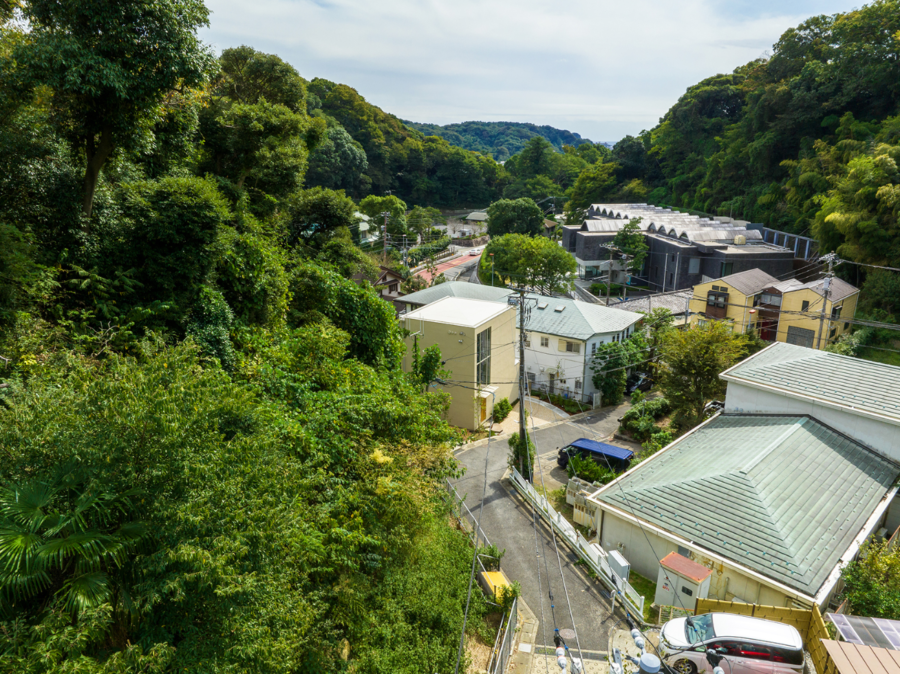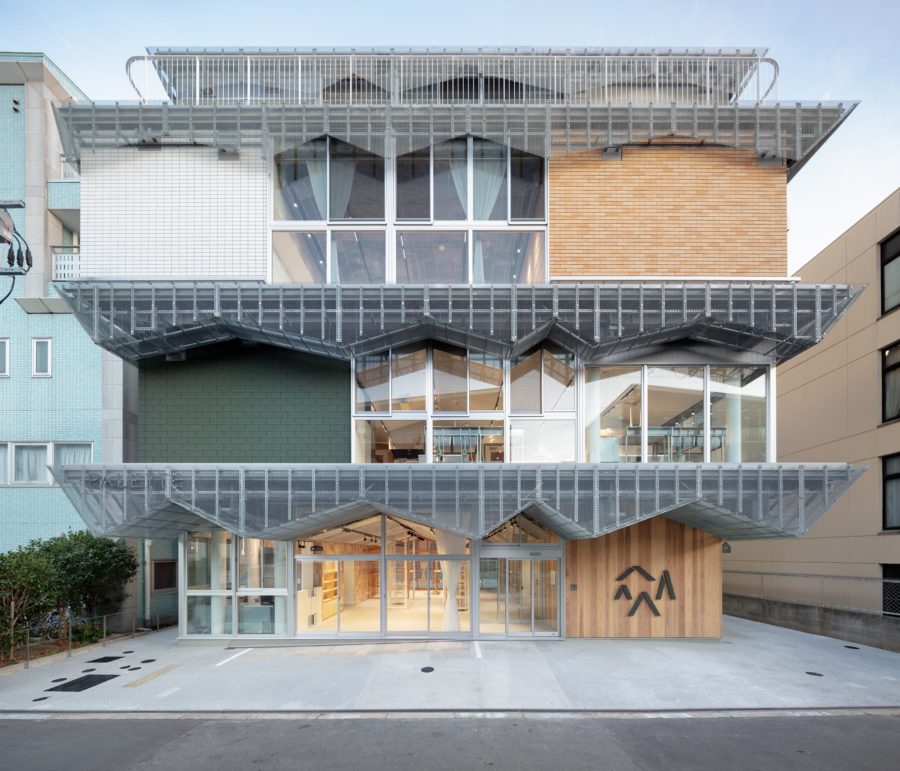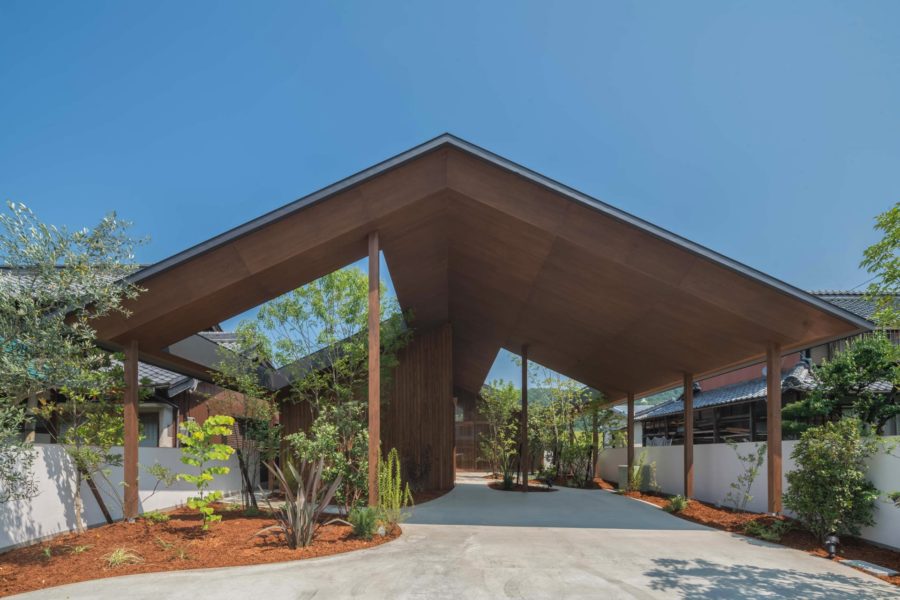場所に縛られずさまざまなことができる時代。
景色のよい琵琶湖沿いの土地を探し始めて3年ほど経ったとき、築100年の空き家と出会い、私たちの住宅兼アトリエ・イベントスペースにリノベーションした。
20年間空き家であった家屋は柱が白蟻に喰われ、数本浮き梁にまで到達する勢いであった。
今回のようなリノベーションは意外に時間やお金や手間、制約もかかる。解体して新築するほうが安く工事もやりやすく早かったであろう。しかし、スクラップアンドビルドが繰り返されるなか、単純にその地にあったものはできるだけ使い、新築では表現できない部分を残したい思いから、リノベーションすることを選んだ。
玄関の大きな引き戸を開けると琵琶湖の景色が飛び込んでくる。訪れる人たちの視界からいったん琵琶湖を遮るように道路側の開口をあえて少なくし、閉じることで生まれた情景。
一方で閉じるだけでは閉鎖感が出てしまうので、道路側の建物一部を減築し、縁側のような部分をつくることで街行く人が座ったり、コーヒーを淹れたりできるようなカウンターを設置し、家を街に開くような計画もしている。
中間期には玄関の扉を開け放ってみたいとも思う。家を街に開くことでどのようなことが起きるのか楽しみな部分もある。
延べ床面積28坪のスペース。ここに居住空間、事務所、イベントスペースを確保することは単純に考えると無理があった。しかしそれらの振り分ける空間をシェアすることとした。1階には普段居住空間であるフリースペースとキッチンスペースがある。それらのスペースを打ち合わせやイベント時に使用することにより、限られたスペースでもすべての機能を満たす空間になると考えた。ギャラリー展示期間中は作家さんの作品に触れながらの生活になるかもしれない。このように職住分離から職住一体になることは、子供や私たちにとっても新たな出会いとデザイン思考向上の始まりになるのかもしれない。
この建物の解体時に出た床板、ガラス、石を再利用した。
鉄職人松本さんによる鉄のフレームを床板と組み合わせ、打ち合わせテーブルに再生させた。
ガラスは、アーティスト周防さんにより鏡へと生まれ変わった。
延べ石を、エントランス踏み石に。
キッチン壁は、左官職人下原さんと打ち合わせを重ねてできあがったシンプルなモルタル左官を荒く仕上げた壁と、鉄職人松本さんによる無骨な鉄棚が壁から伸びる。対面階段吹き抜けにはそれらと呼応するように、和紙職人ハタノワタルさんによる柔らかな和紙貼りが大きな壁面に広がる。木、モルタル、鉄、和紙…それらが調和する空間になった。
外観は細い杉板で目地を取りながら留めていくことで、新たな装いになりつつ、かつての風貌を延長させ、街に馴染ませた。(藤田時彦)
An atelier and residence that has been renovated by inheriting the 100-year-old time
Nowadays, we can do various things without being bound by location.
About three years after I started looking for a piece of land along the scenic shores of Lake Biwa, I came across a 100-year-old vacant house and renovated it into our home, studio, and event space.
The house’s pillars, which had been vacant for 20 years, had been eaten by termites, and the termites had almost reached the beams.
Renovations like this take an unexpected amount of time, money, effort, and restrictions. It would have been cheaper and faster to demolish the building and build a new one. However, in repeated scrap-and-build, we chose to renovate the building simply because we wanted to use what was there as much as possible and preserve the parts that cannot be expressed in new construction.
When you open the large sliding door of the entrance, the view of Lake Biwa jumps into the room. This scene was created by reducing the number of openings on the street side and closing the door to block the view of Lake Biwa from visitors.
On the other hand, closing off the street side of the house would give the impression of closure, so we reduced a part of the building on the street side to create a veranda-like area where passersby can sit and make coffee thus opening up the house to the city.
In the interim, I would like to open up the front door. I am looking forward to seeing what will happen by opening the house to the city.
The total floor space is 28 tsubo (about 92.6m²). It was simply impossible to secure living space, an office, and event space in this space. There is a free space on the first floor that is usually used for living and kitchen space. On the first floor, there is a free space and a kitchen space, which are usually used as living space, and by using these spaces for meetings and events, we thought we could create a space that fulfills all the functions even in a limited space. During the gallery exhibition period, we may live in contact with the artists’ works. This shift from a separation of work and residence to the unification of work and residence may be the beginning of new encounters and improved design thinking for the children and us.
The floorboards, glass, and stones from the demolition of this building were reused.
The iron frame by Mr. Matsumoto, an iron craftsman, was combined with the floorboards and reused as a meeting table.
The glass was transformed into a mirror by artist Suo.
Extending stones were used as stepping stones at the entrance.
The kitchen wall is a simple mortar plastered wall finished with rough plastering by the plasterer Shimohara and a rugged iron shelf by the ironworker Matsumoto extends from the wall. On the opposite side of the stairwell, a large wall of soft washi paper by the washi paper craftsman Wataru Hatano echoes the walls. Wood, mortar, iron, and Japanese paper… these elements are in harmony in this space.
The exterior of the building was finished with thin cedar boards with joints to give it a new look while extending its former appearance and making it fit in with the city. (Tokihiko Fujita)
【umi】
所在地:滋賀県高島市今津町
用途:戸建住宅、事務所
クライアント:個人
竣工:2021年
設計:atelier umi
担当:藤田時彦
和紙:ハタノワタル
テーブル、キッチン鉄棚:松本健司(HALO)
鏡:周防苑子(HACOMIDORI)
外構:鶴園外構店
サインMATUREWARE
施工:Blue Wood Work
撮影:藤田時彦
工事種別:リノベーション
構造:木造
規模:地上2階
敷地面積:113.00m²
建築面積:63.21m²
延床面積:94.55m²
設計期間:2019.09-2020.09
施工期間:2020.10-2021.03
【umi】
Location: Imazu-cho, Takashima-shi, Shiga, Japan
Principal use: Residential, Office
Client: Individual
Completion: 2021
Architects: atelier umi
Design team: Tokihiko Fujita
Japanese paper / washi: hatano wataru
Table, kitchen iron shelf: Kenji Matsumoto / HALO
Mirror: Sonoko Suo / HACOMIDORI
Exterior: Tsuruzono Garden & Exterior
Sign: MATUREWARE
Contractor: Blue Wood Work
Photographs: Tokihiko Fujita
Construction type: Renovation
Main structure: Wood
Building scale: 2 stories
Site area: 113.00m²
Building area: 63.21m²
Total floor area: 94.55m²
Design term: 2019.09-2020.09
Construction term: 2020.10-2021.03








